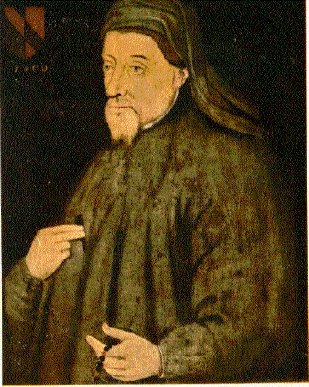The directory «Plots»
Chaucer Geoffrey
(1344?–1400)

English poet, one of the most important figures in English literature.
The known facts of Chaucer’s life are fragmentary and are based almost entirely on official records. He was born in London between 1340 and 1344, the son of John Chaucer, a vintner. In 1357 he was a page in the household of Prince Lionel, later duke of Clarence, whom he served for many years. In 1359–60 he was with the army of Edward III in France, where he was captured by the French but ransomed.
By 1366 he had married Philippa Roet, who was probably the sister of John of Gaunt’s third wife; she was a lady-in-waiting to Edward III’s queen. During the years 1370 to 1378, Chaucer was frequently employed on diplomatic missions to the Continent, visiting Italy in 1372–73 and in 1378. From 1374 on he held a number of official positions, among them comptroller of customs on furs, skins, and hides for the port of London (1374–86) and clerk of the king’s works (1389–91). The official date of Chaucer’s death is Oct. 25, 1400. He was buried in Westminster Abbey.
Chaucer’s literary activity is often divided into three periods. The first period includes his early work (to 1370), which is based largely on French models, especially the Roman de la Rose and the poems of Guillaume de Machaut. Chaucer’s chief works during this time are the Book of the Duchess, an allegorical lament written in 1369 on the death of Blanche, wife of John of Gaunt, and a partial translation of the Roman de la Rose.
Chaucer’s second period (up to c.1387) is called his Italian period because during this time his works were modeled primarily on Dante and Boccaccio. Major works of the second period include The House of Fame, recounting the adventures of Aeneas after the fall of Troy; The Parliament of Fowls, which tells of the mating of fowls on St. Valentine’s Day and is thought to celebrate the betrothal of Richard II to Anne of Bohemia; and a prose translation of Boethius’ De consolatione philosophiae.
Also among the works of this period are the unfinished Legend of Good Women, a poem telling of nine classical heroines, which introduced the heroic couplet (two rhyming lines of iambic pentameter) into English verse; the prose fragment The Treatise on the Astrolabe, written for his son Lewis; and Troilus and Criseyde, based on Boccaccio’s Filostrato, one of the great love poems in the English language (see Troilus and Cressida). In Troilus and Criseyde, Chaucer perfected the seven-line stanza later called rhyme royal.
To Chaucer’s final period, in which he achieved his fullest artistic power, belongs his masterpiece, The Canterbury Tales (written mostly after 1387). This unfinished poem, about 17,000 lines, is one of the most brilliant works in all literature. The poem introduces a group of pilgrims journeying from London to the shrine of St. Thomas à Becket at Canterbury. To help pass the time they decide to tell stories. Together, the pilgrims represent a wide cross section of 14th-century English life.
The pilgrims’ tales include a variety of medieval genres from the humorous fabliau to the serious homily, and they vividly indicate medieval attitudes and customs in such areas as love, marriage, and religion. Through Chaucer’s superb powers of characterization the pilgrims—such as the earthy wife of Bath, the gentle knight, the worldly prioress, the evil summoner—come intensely alive. Chaucer was a master storyteller and craftsman, but because of a change in the language after 1400, his metrical technique was not fully appreciated until the 18th cent. Only in Scotland in the 15th and 16th cent. did his imitators understand his versification.
Dominica, 2000, The Canterbury Tales
Great Britain, 1976, Woodcut from «The Caterberry Tales»
Guinea, 2000, Geoffrey Chaucer
St. Vincent, 1990, The Canterbury Tales
Great Britain, 1976.09.26,  Canterbury. Printing of «The Caterberry Tales»
Canterbury. Printing of «The Caterberry Tales»